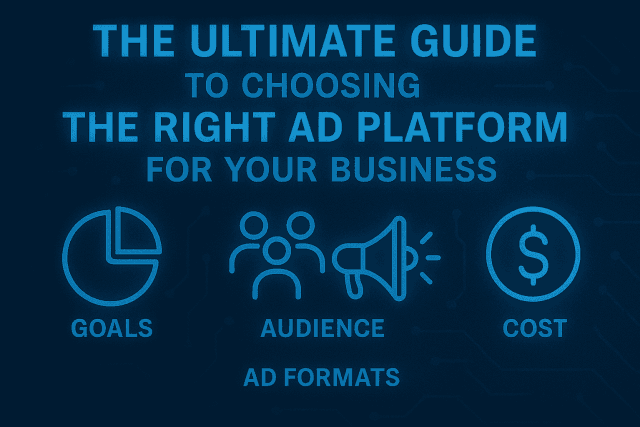In today’s digital landscape, selecting the right advertising platform can be the difference between a successful campaign and wasted resources. With a plethora of options available, businesses need to carefully assess their goals, audience, and budget. This guide dives deep into various ad platforms, helping you make an informed choice that aligns with your business objectives.
1. Understanding Your Advertising Goals
Before choosing an ad platform, define your advertising objectives. Consider the following:
- Brand Awareness: Are you looking to introduce your brand to new audiences?
- Lead Generation: Do you aim to drive inquiries or gather contact information?
- Sales Conversion: Is your primary goal immediate sales or e-commerce transactions?
- Customer Retention: Are you focused on re-engaging past customers?
Clearly identifying your goals will help narrow down your options.
2. Know Your Target Audience
Understanding your audience is critical. Research demographics, interests, and online behaviors to determine where your potential customers spend their time. Key questions include:
- Who are your ideal customers?
- What platforms do they use?
- Where are they located?
Different platforms cater to specific demographics, so aligning your audience with the right channel is vital.
3. Popular Advertising Platforms
a. Google Ads
Best For: Wide reach, search intent-based marketing.
- Pros: Access to the largest search engine; robust targeting options; various ad formats (PPC, display, video).
- Cons: Competitive bidding; requires continuous optimization; can be costly for high-competition keywords.
b. Facebook Ads
Best For: Social engagement, brand building.
- Pros: Powerful audience targeting; diverse ad formats (carousel, video, stories); integrates well with Instagram.
- Cons: Algorithm changes can impact reach; users may face ad fatigue.
c. Instagram Ads
Best For: Visual storytelling, younger audiences.
- Pros: High engagement; visually attractive formats; ideal for brands with strong imagery.
- Cons: Less effective for direct sales; relies on quality visuals.
d. LinkedIn Ads
Best For: B2B marketing, professional services.
- Pros: Highly targeted for professionals; great for lead generation; options for sponsored content.
- Cons: Higher cost per click; may not be suitable for all industries.
e. Twitter Ads
Best For: Real-time engagement, customer interaction.
- Pros: Quick dissemination of information; trending topics boost visibility.
- Cons: Limited character count; can be volatile in terms of user engagement.
f. TikTok Ads
Best For: Creativity, engaging younger demographics.
- Pros: Rapidly growing platform; high engagement rates; innovative ad formats like challenges and branded effects.
- Cons: Limited analytical tools; requires fresh, creative content frequently.
4. Budget Considerations
Be mindful of your budget when choosing an ad platform. Consider these factors:
- Cost per Click (CPC): Understand the bidding landscape of your chosen platform.
- Minimum Spend Requirements: Some platforms have minimum ad spend requirements.
- Potential ROI: Assess the expected return on investment for each platform based on similar campaigns in your industry.
5. Measuring Success
Regardless of the platform chosen, set up proper tracking to measure ad performance:
- Metrics to Monitor: Click-through rate (CTR), conversion rate, cost per acquisition (CPA), return on ad spend (ROAS).
- Adjusting Campaigns: Use A/B testing to optimize ad performance; refine targeting and creative based on analytics.
6. Evolving Strategies
As technology and consumer behavior change, stay adaptable:
- Keep Current: Regularly update your knowledge about the platforms.
- Test New Options: Don’t hesitate to experiment with emerging platforms or trends.
- Engage with Your Audience: Use feedback and analytics to refine your strategies continually.
Conclusion
Choosing the right ad platform is a strategic decision that requires careful consideration of your business goals, audience, and budget. By understanding the strengths and weaknesses of various advertising channels, you can optimize your advertising efforts for maximum impact. Remember, the landscape is continually changing, so stay informed and be prepared to adapt your strategy as needed. With the right approach, your advertising can drive significant business growth and visibility.







